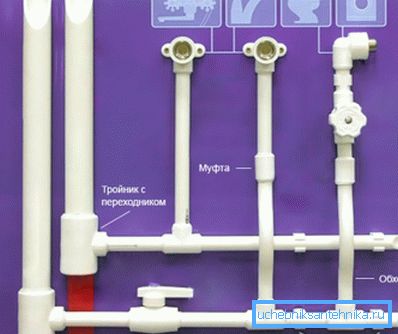Fittings for pipes: the main types and features of the
In this article, we will talk about what pipe fittings are, what kinds of varieties it is on the market, and what are the features of its use.

Main varieties
If there are pipes and they have to be joined by their own hands into a single sealed system, special connecting elements with the appropriate sizes and configuration will be required.
The connecting elements used for the construction of pipelines, in accordance with the type of pipe, are divided into polymer and metal. In this article we will look at what modifications on the market are the accessories for plastic pipes for water supply and for their metal counterparts.
All accessories, regardless of the materials used in its production, are divided into three categories:
- fitting;
- stop valves;
- additional fittings.
Consider the features of each of these categories in more detail.
Types of fittings

In accordance with the purpose of the fittings are divided into the following types:
- corners and bends - change the direction of pipelines by 45, 90 or 120 degrees.
- collectors and tees - are used for device branches from the main line.
- crosses - intended for the device of branches in two directions from the highway.
- couplings - used to connect pipes with the same diameter in a straight section.
- Adapters (nipples, sgony and futorki) are used to connect different pipes in the same system.
- caps (caps, corks) - are used for sealed end pipe.
- fitting - used to connect rigid water supply with flexible hoses.
In accordance with the material used in production, connecting elements are divided into the following categories:
- Fittings used for the installation of metal plumbing can be threaded, crimp, flanged or welded.

Welded modifications are equipped with a smooth finish that fits into the pipe and is welded to make a tight joint.
No less popular threaded connection, which is used on most household systems. The only drawback of such a connection is that it cannot provide residual tightness, and therefore special seals such as the sealing ring, tow, fum-tape, etc. are used.
Crimp connection is used less frequently, since it requires a special tool.
Important: The compound obtained in this way is not intended for recycling. However, it provides the maximum level of tightness and reliability.
The flange connection is used in industrial pipelines and is performed using bolted fixation.

- Fittings for metal pipes is designed to perform a collet or collet-threaded connection. The most reliable type of compound on metal-based laminate is the use of compression fittings.

As well as compression fittings for metal pipes, products for compression of metal-based laminate are designed for single use. Therefore, before cutting the tube for crimping, you need to accurately measure everything so that you do not have to cut the used fitting and install a new one in its place.

- Fittings for polypropylene pipes are fittings that are connected to the pipeline by soldering.. Special equipment is used for soldering, which heats the seat and the end of the pipe to + 260 ° C.
The parts warmed to the required temperature are joined, centered and held in the required position until the plastic is completely cooled. After the plastic is cold, it turns out almost monolithic tight and durable compound, the price of which is low.
Valves

Stop valves are fittings for shaped pipes and their round counterparts, designed to shut off the supply of water or other transported medium.
Modern valves are represented on the market by the following varieties:
- cranes - are applied in various pipelines, both in household, and industrial;
- gate valves - used in industrial systems;
- valves (valves) - used in industrial systems;
- dampers (butterfly valves) - used in industrial systems.
Important: When choosing valves, pay attention to the markings on the body of the product. The marking contains data on the conditional passage, on the conditional pressure, on the maximum allowable temperature of the transported medium, on the direction of flow and on the material used in the manufacture of accessories.
Additional fittings
Additional accessories for propylene pipes are represented by the following range of products:
- Fastening clips - represent the brackets intended for fastening on firm vertical and horizontal surfaces.
The inner diameter of the product corresponds to the outer diameter of the pipe. Thus, the fastener is fixed with a dowel on the wall, and the pipe is inserted into the product and securely held.
The advantage of such fasteners is that, despite the reliability of fixation, the pipeline can be displaced longitudinally.
- Passing levels intend for installation of water mixers. Due to the strips through passage, the need to use connecting fittings is eliminated.
- Bends - finished parts of the pipeline, produced in the factory.
- The contours are devices that allow to bypass various obstacles in the path of the pipeline. Structurally, such products are a pipe section in the form of an arc with sockets at both ends.
- Linear expansion compensator is a special device designed for use on heating systems built with the use of polypropylene pipes.
Conclusion
Now you know what the fittings used for the construction of pipelines are. Moreover, now you know the general instructions for the use of these products.
Do you have any questions that need clarification? More useful information you can find by watching the video in this article.